|
Tsa-rLung, Ajna, Reiki & Energotherapy Healing
Research
_________________
Guidelines ________________
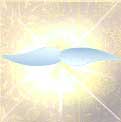
Whom Does the Grail Serve
?
Presentation
Keltic-
Trilogy (Cairn) invites you to join us in
the comparative
training discovery of the Tibetan
Tsa-rLung, Ajna, Reiki
& Energo-/ Chromo- therapy Healing
& Divination practices from experiential seminars,
teachings and retreat organized at selected Vajrayana
pilgrimage sites in the Himalayan region (India/Nepal/Tibet),
as well as in Europe during pilgrimages and studies organized
in South-of-France and Wales at Celtic, Magdalene,
Cathares and Templars Powerplaces.
This is an
entirely new serie of Introduction
Conferences, Experiential Seminars
and Cultural Immersion Research
options, focusing on the comparative approach of Energotherapy (Zeberio) and Tibetan Medicine
Tsa-rLung
Healing Practices, being organized in Nepal and Europe, during the
academic year 2004-05, and now operational
from next October 2004 in Nepal.
Emphasis will be brought to
:
![]() Tsa-Lung Energy Body
Healing (Self-healing, Chi, Tantra) Tsa-Lung Energy Body
Healing (Self-healing, Chi, Tantra)
![]() The Body of Light (a
synthesis with Dzogchen practices) The Body of Light (a
synthesis with Dzogchen practices)
![]() The Philosophy and
Diagnosis in Tibetan Medicine The Philosophy and
Diagnosis in Tibetan Medicine
![]() The "Six Lamps of
Confrontation" (Thigle) The "Six Lamps of
Confrontation" (Thigle)
![]() Healing Archetypes and
Practices in the Celtic Heritage Healing Archetypes and
Practices in the Celtic Heritage
This paper is about the
comparative study of the Healing Traditions in Celtic, Bon and
Tibetan Buddhist roots Shamanism, including the existential
notions on Tantra and Dzogchen. It is also naturally about a
renewal of East-West psychology schools exchange. Thus, it
wants to approach the Tibetan healing and divination
traditions in light of a renewed theory. If you read these
lines you will gain more insight not only on Tibetan Tsa-rLung
Healing and Ajna Yoga, but also in the common roots being
rediscovered for a synthesis approach of the Asian and Celtic
Shamanic Roots as found in the Celtic, Vedic and Tibetan
Healing (Body of Light) traditions. The Tsa- rLung Subtle
Energy Body can be perceived from the Ajna Yoga asanas,
Tsa-rLung visualization and Tai-Ji movements which open up the
consciousness level to the appraisal of subtle energy, so that
the breath flows freely in the body. There are other means,
tools or rituals, such as Sacred Dance
performances, which can bear also such testimony. Here, the
Tsa-rLung Tibetan traditions alone is not the purpose. What is
worth taking some time to study, in the present globalisation
of the East and West exchange, is the hypothesis of a common
Archetypal and Artefacts background, and a proposed
experiential methodology to test it. This may provide more
insights on the relations between consciousness and the
appraisal of subtle entities, protectors and elements, and how
such elemental qualities manifest themselves in our lives.
More easily, it also offers tools being rituals or embodiment
context for us working in both the Celtic or Tibetan
Powerplaces. Cairn feels, in the same way as many Tsa-rLung
Lamas, Healers and Shamans interviewed thereupon, that through
the bringing together of a network for a Body of Light
awareness and flow of its Knowledge qualities, we can also
promote peace and awareness in our lives and people, at
helpful, practical and tangible level.
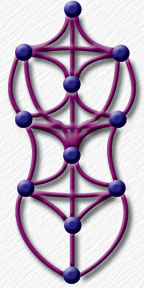
General
Methodology
Cairn R&D methodology
requisites are accordingly in three inputs:
1- Inputs from the Celtic
Archetypal paradigm, reviewed under reference of the Grail
Lore,
2- Inputs from the Tibetan
Tsa-rLung, Tantric Healing and Traditional Medicine
practices,
3- Inputs from a renewed R&D
approach in Energo/Chromo-therapy, such as Prof.
Zeberio,
Studying and practicing texts and
rituals in a comparative approach of Western (Celtic) and
Eastern (Tibetan) Healing Traditions, in their post-modern
condition (where the new dominant paradigm is that there are
no dominant paradigms because times are a changing), increases
our awareness of both the needs to challenge blockage of
established concepts leading to nowhere no more..., and on the
difficult task of experiential scholarly comparison. Though
Cairn is intimately conscious of the experienced traps of
shifting the testimony of emotions and altered states of
consciousness (ASC) into more politically correct literary
concepts (including the hermeneutic assumptions that roots
practices in one tradition can be compared with those in
another), one may find nonetheless such efforts are
worthwhile, if not urgent, because our daily strategic site
appraisal of the quality of relationship between the East and
West is that much of present contradictions are resolved by
people only through a superficial compliance to prevalent
models, and therefore much of the potential fruits of the
spiritual heritage are to be lost from a lack of genuine
awareness or transparent dialogue. Amongst others, in
qualitative research methodology, the concepts of Symbolic Representations and Significance
of the Energy Body manifestation may play a role in the
erasing or easing respective (mis)conceptions, as much on
Tibetan tradition than Celtic, per se ...
The comparative approach of
Significance in the experiential and contexts of the Healing
and Divination practices, may include a study of concepts
(texts), yoga ascetic behaviours (asanas) and mystical
experiences (rituals) at the same time, will use an
Hermeneutic model for ASC qualitative case studies.
This methodology main purpose
could accordingly allow the hermeneutic and experiential in
each cultural framework to be expressed and shared within
their underlying symbolic representation, thus leading the
comparative efficacy of such practices and studies towards a
renewal of Shamanic roots in these universal Healing and Body
of Light traditions!
By employing phenomenology,
clinical anthropology, sociological and anthropological
methodology, Cairn chooses an approach markedly different from
the bulk of current traditional religious text-oriented and
hierarchy- motivated Dharma recruitment or
scholarship.
Rationale
Such a methodology maybe
validated upon the following premises:
A- Inputs from the Celtic
Archetypal paradigm reviewed under reference of the Grail
Lore, will allow an ethical embodiment of researchers within
the Celtic Heritage collective unconsciousness level of the
overlapping Euro and Central Asian mythological and shamanic
heritage. This will allow the envisioned rituals, prayers and
meditation embodiment to be carefully performed in accordance
with the context of most European sacred powerplaces, either
related to the Megalithic period, or later Magdalene, Black
Madona, Cathares, Joseph of Arimathea and Templars
sites.
B- Inputs from the Tibetan
Tsa-rLung Tantric Healing and Traditional Medicine practices,
per se, will allow the practical training in experiential to
be proposed in a stepwise manner, following both the canons of
Tibetan Medicine and Tantric Healing, under the advice of
Tsa-rLung Nagpas, supervision in situ.
C- Inputs from a renewed R&D
approach in Energo/Chromo-therapy, such as in the previous
training being proposed since 30 years by Prof. J.T. Zeberio
(Ag), will allow participants to grasp more experimentally the
existence of the subtle energy, its healing powers and
visualization of their Energy Body of Light, in a clear and
simple manner, above all devoid of religious political
premises, and first focused on awareness.
Celtic Options include a
Tour&Study Introduction to Shamanic Healing and
Divination Practices,
proposed in the sacred sites of Montsegur
and Alet (Aude and Ariège Pyrénées, France), as well
as
in the Verdon Canyon (Basse Alpes, France). This
flexible program may also include a 2 Days Seminar.
The
first two weeks in France focus on the Cathares and Templars
heritage in the Aude and Ariege region (Pyrenees), including
visit, meditation and experiential at Montsegur, Alet
monastery and Rennes le Chateau / Razes, Limoux and several
Templars or Cathares Magdalene related holy waters. These can
be followed, at the end of the second week, with a discovery
of selected sacred sites related to the legend of St- Mary
Magdalena and Joseph of Arimathea, in such known places
as: Les St- Marie de la Mer, Aix and Ste Baume.
Further details (2003) are
presented at : https://cairn-erasmus.tripod.com/verdon.html
and here (1997): http://users.skynet.be/keltic/
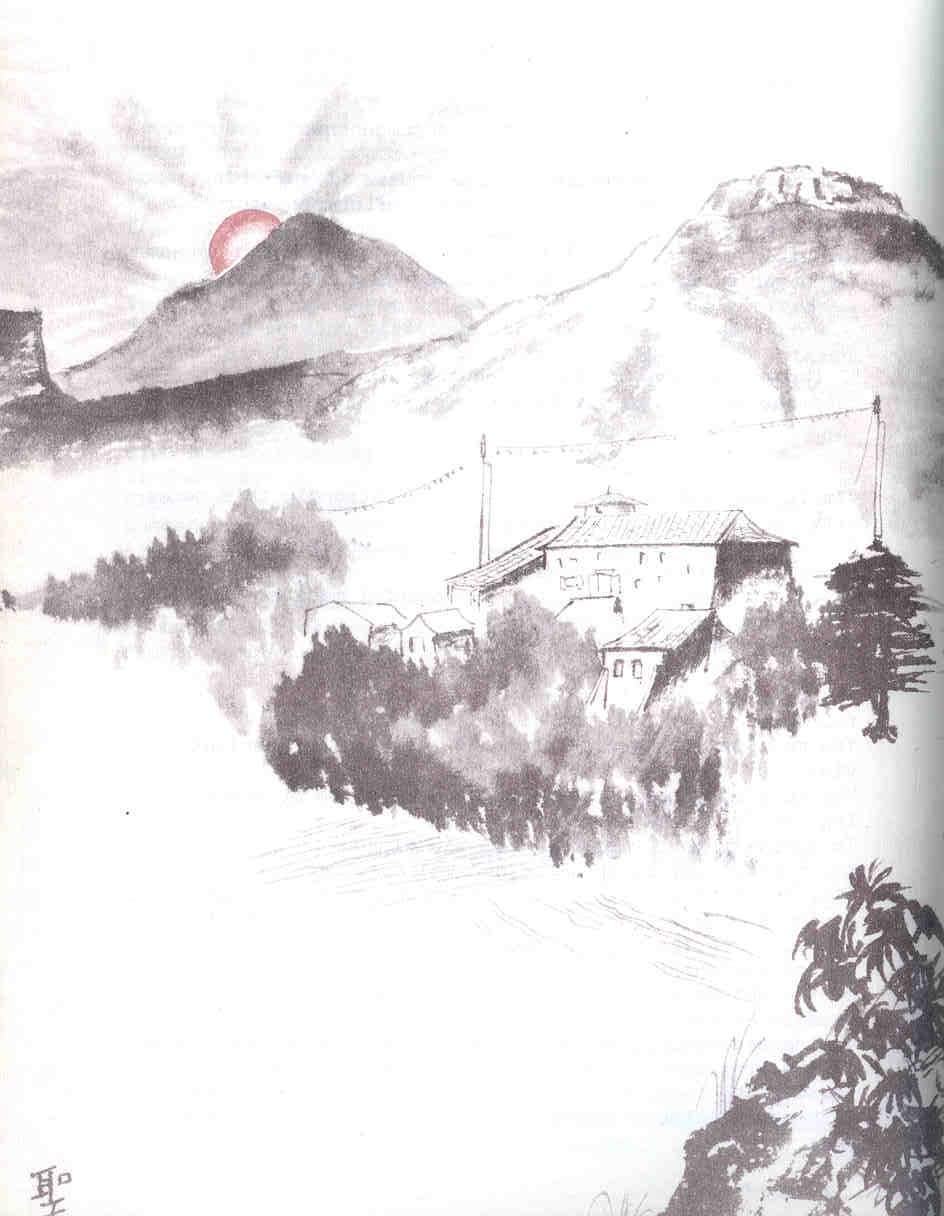
Nyima - Dzong (c)
OKC 1973
Methodological
Options
Following the methodology above,
more details on the three options are presented here (click
here:)
1-
Inputs from the Celtic Archetypal paradigm, reviewed under
reference of the Grail Lore,
2-
Inputs from the Tibetan Tsa-rLung, Tantric Healing and
Traditional Medicine practices,
3-
Inputs from a renewed R&D approach in
Energo/Chromo-therapy, such as Prof. Zeberio,
These first set of options may
be completed with CAIRN Field-studies and Research
Programmes being organized in the KTM and
Himalayan region (Nepal/India/Tibet), which are purposely
designed for clinical professionals, researchers, students and
scholars, and organized from selected resources in Nepal,
India, Tibet (TAR/China) and S-Asia.
These programmes can be of a
duration from 15 to 21~ days, and upto 4 months
.
Since 1988, CAIRN
Cultural Immersion tours cum experientials have
focused
on clinical
anthropology, ethno-medicine and counselling research, as well
as on
the Comparative Study of the roots
archetypes, symbolic and practices of the
Himalayan and Celtic Shamanic Healing and Divination
Roots Traditions, at the
philosophical,
experiential and hermeneutic level required.
Each Field-study is duly
tailored on a specific subject, upon the
participants
interest and with
personalized modalities under a personalized
contract.
Further details are
presented at : https://cairn-erasmus.tripod.com/itinerary.html
Cairn academic exchange
also promotes Cross-cultural Awareness and Volunteer Work
options.
Further details are
presented at : https://cairn-erasmus.tripod.com/indextwo.html
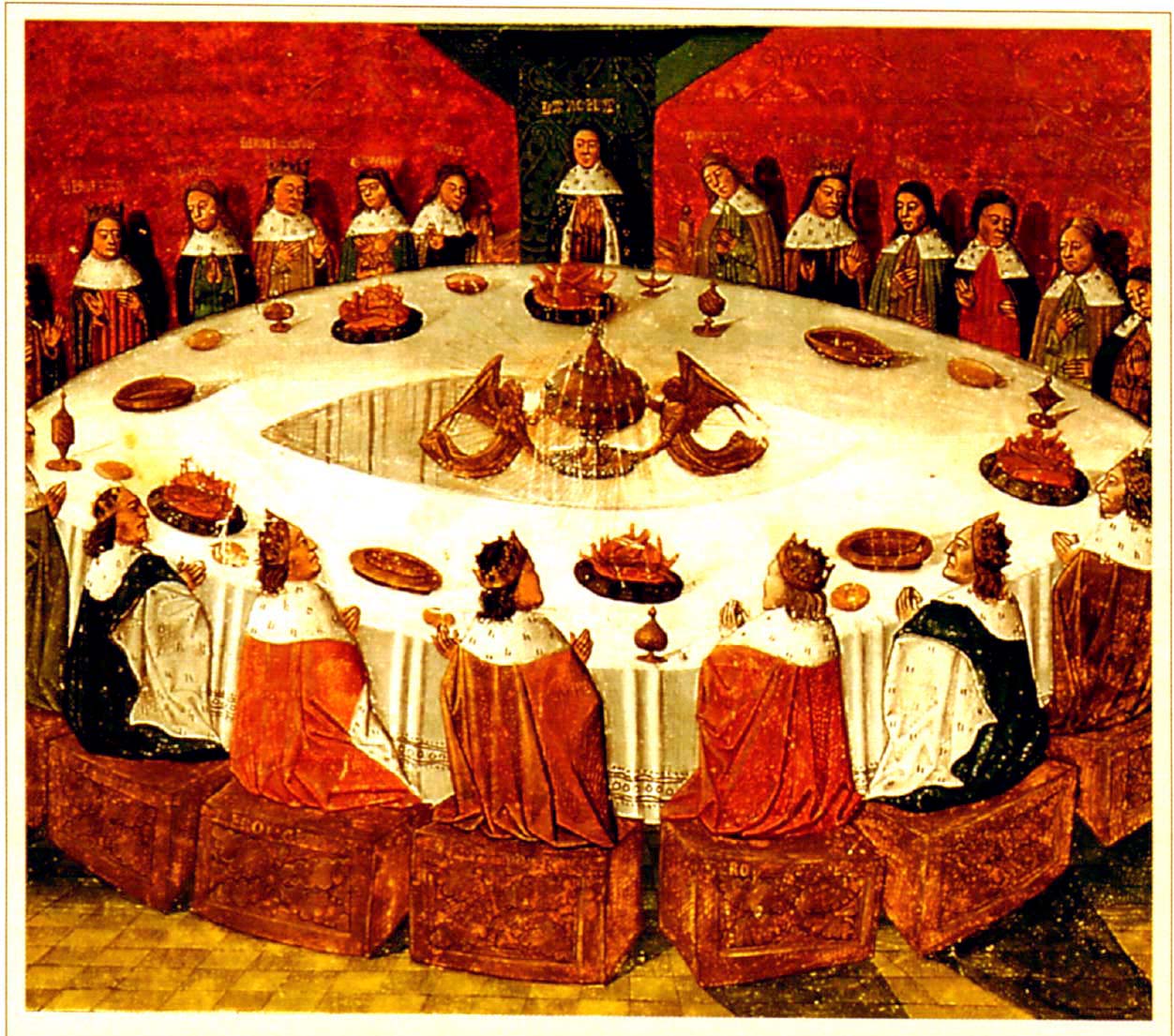
The Holy Grail appears to the
Knights of the Round Table, with Sir Galahad in the Perilous
Seat
( Legends of Arthurian Quest, painting of the
13nd century).
Enter the
Quest!
Caer
Sidi, The Fortress of the Fairies is
mentioned in the Book of Taliesin (Lewis Spence).
That Caer Sidi (Camelot)
was the Seat of rituals and initiations for Healing and
Divination of an extraordinary vitality and importance to the
Celtic psyche is no new thesis . But that it can be
re-awakened today, simply through a comparative
experiential study of Grail Lore and Himalayan Tantric
Shamanism is a testimony we want here to share , as a
research, with you.
The roots of myths and rituals go
down to the subsoil of grave-cult and fear of death. E.
Durkheim and K. Jung often argued that the collective
excitation (sur-excitation) of clans, tribal and Shamans
rituals were experienced by participating members as
trans-personal (impersonal), overwhelming power (Mana) ,
though to emanate from the clan archetypes (or
collective unconsciousness) represented (embodied) in the
Totem. The Totem would then induce with Mana all
associated symbols, uniting the tribe in a single system of
beliefs, practices and representations.
The word Sidhe (also
spelled Sidi, Sidh, Sid, Sith ...) may be regarded as the
standard term for "fairy" in the Gaelic tongue of Scotland ,
Wales and Ireland. While some reliable authorities further
stress that Sithide or Sithde is the genitive
of Sithd, a female fairy, Gaelic records Sidhe
as also implying "hill" or "mound". Mounds and hills often are
both graves and abodes of the elves.
Mythology is social psychology,
as much as it is archetypes, history, cosmology or biography.
Myth is a picture language, which has to be studied and
embodied to be read.
And Mythology is also alive ...
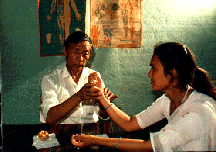
Amchi Kunzang /
Kunphen
Reality Check?
This paper does not want to argue
that Shamanic Healing and Divination practices are an object
of ethnographic study, but rather that the introduction to a
comparative experiential embodiment and study may be
approached, under genuine professional guidance and relevant
references, using the current resources in the Celtic and
Himalayan culture. This process may include the exploration
of altered states of consciousness (ASC) leading to
development of potentials and discovery of Self .
Myths, as they have settled in
history and popular tales are the purveyors of a wisdom that
was born with the race of Man. The content is metaphysics .
The equation between the Celtic Grail Lore (Healing and
Divination practices), the Tibetan Tantric and the
Indo-European Rig-Vedas mythology may be as much approached
from a comparative experiential study of the archetypes and
rituals, than discussed from the available references existing
in both the holy scriptures of early Christendom and those of
the Tibetan Vajrayana and Dharma.
The literature references include
the narration of the first century (AD) exile of
several apostles closed to Jesus the Christ, namely: St.
Philip, Simon Zelotes, Mary Magdalene, Joseph of Arimathea
(James) and others first to Septimania (South of
France), then to Brittany and Wales.
Testimony itself followed
by the Celtic legends of the Arthurian Grail Quest and Saints
(St. David, St. Patrick) and the historical recollections
of the successive migrations of the Arianist faith
tribes (Wisigoths, Huns, Germans, Franks) , which led to the
end of the Roman Empire (West) and to the consolidation of the
(Long Hair Sorcerers) Merovingien kings in the previous
Septimania , then named the Razes around Rennes le Chateau and
Limoux (Aude) . Originating from the Black See
(Central Europe) and Asian steppes, the Shaman practices
of early Christendom was blended in an intricated
mythological background, where Runnes , Animal Spirits ,
War Protectors , Fairies, Angels or Saints were part of a
practical Gnostic Gospel . It is enlighting to find today how
much these early Shamanic concepts and practices have
remained comparable , at the symbolic archetypes and rituals
level, to the current Hindu and Buddhist Tantras (ie:
protectors, Dakinis, skulls, vases, Samsara or
maya , reincarnation or karma, etc) . The early Christendom
literature shows that these were beliefs being alive in the
practices of Cathars and Knights Templars .
Sufficient literature material
exist to complete the archeological and
traditional traces which survived ( ie: Celtic
scriptures, Dead See Scrolls, testimonies on the Cathars
Consolamentum , Chinese Nestorian and Troubadors legacies ).
This allows Grail Lore symbols and rituals
to be compared with their early (Indo-European) Rig
Veda's inspiration . Indeed, both the Celtic and Tibetan
Vajrayana (Guru Rimpoche comes from mythical Orgyen land, West
of Tibet) realms somehow emerge from the same Central
Asian / Indo-European sources, with common archetypes burried
deep in the collective unconsciousness of both the
Celtic and Himalayan mystical approaches.
While there is no dispute
concerning the historical and archeological facts that
the early Celtic tribes migrated from Central Asia (since
4.000 B.C) , to be followed later (from 500 to 1.000 A.D.) by
the successive migrations of Huns, Franks, Goths, Wisigoths
and other Germanic tribes practicing Shamanic rites, it is
less known that some of the current Shamanic traditions in the
Himalayas today, namely those of Rais, Limbus and
Tamangs ethnic descents, still speak about their own long past
migration from a Central European region of which their
present megalitic practices bear testimony .
Myths belong to the world of
rituals and symbols, and one's perception of them is a matter
of personal Quest, Embodiment and Awareness , as much as a
path to be with genuine ethics .
We could consider , for example,
as a valid hypothesis for experiential and literature studies,
the few references in the Rig Veda of human interactions
(or relations) with the Gandhavaras (Spirits of the Air and of
the Waters) and Apsaras (water nymphs) , in charge
of the magic Soma and were skilled in medecine and music.
These entities bear resemblance with the roles played by
Celtic Fairies (spirits) or the Grail Lore Ladies of the Lake
(Waters, or del Acqs), who as Vivianne del Acqs and Morgane Le
Fay , are the Guardians of the Isle of Avallon (Avallach), the
invisible Gates to Caer Siddi (Annwn) and to the Grail's vase
divination and healing powers.
As in the Rig- Vedas and the
Vajrayana, the earlier version of the Arthurian Quest
and the later Troubadors Lore promote a sophisticated
mythology , with archetypal roles perceived in distinct
classes of inspirations, being those of Morgane, Perceval,
Arthur, Morded, Merlin, Fairies , Maids or Celtic
Nymphes, conduced in tales known as Elopments ,
Wooings or Arthurian Quest.
The discovery of hidden
truths, embedded in mythology is as much part of an initiation
process, belonging to the realm of personal
catharsis or drama , than to rationality.
Caer Sidi (Annwn), the Celtic and
Grail Lore Abode, which entry gives access to Healing and
Divination Powers, requests that one be motivated , as Arthur,
Galahad and Perceval , by a drive for relevant services
and compassion for the community.
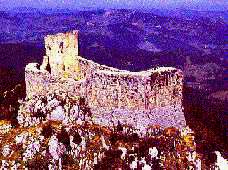
Montsegur
Pog
The Asian Roots
of Grail Artefacts and
Mythology
In s-of-France, Belgium, UK and
Nepal, questions have arisen around the use of Tibetan Dharma
roots shamanic rituals in selected Celtic, Templars and
Cathares Powerplaces, and on the issue of how, where and
why these Tibetan Nyingmapa rituals were in any way compatible
with the Celtic Grail Lore archetypal heritage, in
situ...
Maybe one needs to remember first
that the Celts, Kelts or Keltoes, originated from Central Asia
before their various tribes found suitable places after
roaming through Central Europe, and settled down in Austria,
Germany Switzerland, France, Brittany, Wales and Ireland. This
puts us back to a few thousand of years of continuous so
called Kelts, Scythes, Goths and Sarmatian migrations.
In Professor Littleton's opinion it is from their culture that
the Arthur legend originated along with the legend of the Holy
Grail. French and Jewish scholars however have traced the
legends of King Arthur to Jewish legends concerning Moses and
King David. The idea of the Holy Grail was derived from the
breastplate of the High Priest that had been hidden away
before the destruction of the First Temple. The breastplate
was conducive to prophecy and one of its names was "Gorel"
(whence we have "grail") meaning "lot". It was by means of the
"Gorel or "lot" (Breastplate) that the Land of Israel had been
divided amongst the Tribes (Joshua 19:1).
That is of course if we
understand this Grail breastplate as being only something of
an ornamental or military value, and not as it simply remains
nowadays in Central Asia Roots Shamanic Traditions a
representation of more ritual symbolism linked to practical
spiritual, magical or subtle energy functions, such what would
apply to wear Lamas, Shamans, Priest or Oracles using
artefacts of their traditions, which will emerge at the later
stage within the Grail Lore, Celtic, Cathares or Templars
ritual heritage.
The following commentary is not intended to be the last
word or the definitive presentation on a rather recent,
controversial and evolving subject. Rather, as the title
implies, it is intended to provide a basis for some further
reflections and synthesis , towards an attempt in nourishing
or re-awakening the Celtic archetypes with the present energy
and practices of the Himalayan Shamanic Roots or Tibetan
Tradition, as Tibetans do ...
The contemporary and somehow
successful migration of Tibetan Gompas rituals to
selected Celtic, Cathares and Knights Templars powerplaces in
UK and South of France, such as the strategic sites
which were bought in the early 1970-80s by some Tibetan
Rimpoches in Haute Provence (Verdon) and Septimania
(Aude/Ariège) in the South of France (ie:
Kangyur Rimpoche and Dudjom Rimpoche of the Nyingma-Pas
bought in the early 70s the old Templar Chateau Soleil , now
called Nyima-Dzong, situated near the Celtic Fortress of
Valcros / Verdon , while the Sharmapa tried in the begining
80s to buy some land around the Razès / Rennes le
Chateau, and in Scotland itself and more successfully it
seems, Lama Yeshe of the Kargyud-Pas lineage
bought the old Celtic retreat of Holy Island), has beared
testimony that these sacred abodes of the earlier Celtic Lore
Saints and Fairies have proven to be useful resources
for the Tibetans' own rituals and retreats.
While, the biography of these
Tibetan settlements have not been without their share of
controversy, it has become undeniable ( after more than 25
years monitoring these sites ) that in some of them spiritual
awareness had been reached, while in some others the hidden
political , magical and alchemistry impacts were still to be
assessed.
All in all, these are facts on
the Roots and nowadays while quite different results had been
reached by the Tibetans using Celtic and Templar powerplaces,
the question now being if which what has so much beneficiated
the Tibetan rituals settled down cosily, could not also serve
the purpose of preservation and reawakening of the Celtic and
Grail Heritage itself, as not being different fundamentally
but for its awareness to be used by Westerners for other
issues than the Tibetan agenda. In short, if it worked one
way, it could probably work as well the other way round
...
Comparative Tsa-rlung
Healing Research
The purpose of Cairn comparative Tsa-rlung Healing
Research in Energotherapy
Body of Light developmental techniques is primarily to offer
an opportunity to those who are seriously interested in
beginning or deepening their understanding of Tsa-rLung from
options to be found in experiential seminars, cultural
immersion retreat, teachings, powerplace retreat and training
online program for Tsa-rLung practice. The flexible time
between modules will allow participants to practice and study
what was learnt and then apply it in the next level. A
secondary purpose is to train future instructors that will be
able to share with others the benefits of this practice, in
this tradition.
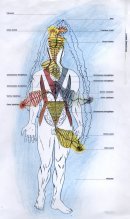
Energy Body (c) Zeberio
The Concept
of Energo Anthropology
(NB: Prof.
J.T. Zeberio Foundation copyrights apply to all quotes from
Zeberio website)
The Cairn
Tsa-rLung concept of Energo Anthropology is directly linked to
the important work and publications achieved during the
last 30 years by Prof. Jose T. Zeberio and his team
(Argentina, UK, Belgium, France) under the new paradigm of
Energetic Anthropology.
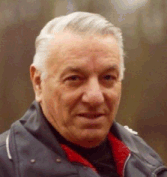
Prof. J.T Zeberio : (c) Zeberio
Prof. Zeberio
concept of ENERGETIC
ANTHROPOLOGY is described in his
writings as a new science and experiential study of the subtle
energy that underlies the genesis, evolution, development and
integrity of all sentient beings and their surrounding Mother
Earth and spiritual context. It proposes a new vision (quoted)
of the origin of life and expounds with some immutable
mathematical precision of the evolution of spirit.
With scientific
endeavour, it describes the birth of a Nucleus of Spirit in
the Centre of the Earth composed of pure electromagnetic
energy. In Zeberio work, we follow the peregrination of this
Nucleus within the mineral, vegetal, animal and human realms,
its realization on Earth as director of the human Soul and its
evolution beyond the terrestrial plane from which it elevates
itself in search of the immense Galaxy. It respects a
chronological progression. It re-establish the human being in
his natural and spiritual context integrating the principle of
consciousness within the vast fields of terrestrial and cosmic
energies. It aims to
link physics, biology, psychology and astronomy in a coherent
system, redefining the place of the human being in its natural
and spiritual context. Evolution is the movement from
matter toward life, from life toward consciousness and from
consciousness toward spirit. Lately, the Zeberio Foundation educational
websites have been created for reviewing the Zeberio
Foundation various ongoing activities in Argentina, Fr and
UK/Be. Seminars in the related disciplines are organized
regularly by the Zeberio team in the EU, namely : Eliane
Clarke (UK), Ylona and Chritian Cayron, in order to
disseminate the pioneering discoveries of Prof. J. T. Zeberio in the field of
Energies and Evolution. These publications contain pages on
all aspects of the energetic structure of living beings,
although these documents represent a very small portion of his
discoveries. (Excerpts above are quoted from the - ZEBERIO ORG
WEBSITE - Prof. J.T.
Zeberio Foundation copyrights apply here above to quotes from
Zeberio website )
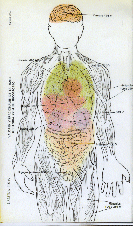
(c)
Zeberio
Professor Jose Tomas Zeberio is an Argentinian
researcher who has brought together the results of his studies
under a renewed paradigm called : " Energetic Anthropology ".
The complete findings of 70 years research are contained in
two volumes, which the author, Jose Tomas Zeberio and his
wife, Dorothea Büttner-Zeberio, have now made available to
actual readers and future mankind. (Excerpts above are quoted from the -
ZEBERIO ORG WEBSITE - )
The
Tsa-rLung Encounter
The doctrine of Tsa-rLung or
spiritual ‘Body of Light’ may be helpful in this approach. The
Body of Light is repeated throughout all Shamanic traditions,
as well as current Tibetan, Chinese, Tantric and Western Grail
or Celtic esoteric literatures. Unfortunately for Westerners
themselves, while many references are made to their Celtic
roots Grail mythology, concepts or archaeology, little
experiential or reliable information is supplied
regarding its effective stages of initiation, roots conceptual
origins, stages of growth or application. The purpose of Cairn
Research, in this difficult context, is to seek genuine
resource providers, test them priorily for then supply
students or researchers with a workable theory and practical
techniques, regarding what remains the obscure subject of
enlightened Body of Light, its powers and resulting
awareness!
In the Tibetan tradition, per se,
our physical body, speech (or energy), and mind, are said to
be with the three doors through which one can practice and
eventually realize enlightenment. The energetic body consists
of subtle channels (tsa) that are the roadways through
which the vital breath (lung, prana, qi) carries the
essential spheres (thigle). This is explained in careful
detail in the Mother Tantra of the Bon tradition, particularly
in the chapter called "the sphere of the elements" (jung we
thigle). Many Nyingmapa and Bonpo yogi masters have
followed this text and based their commentaries on it. Tenzin
Wangyal Rinpoche's Healing recent reading, entitled Working
with Form, Energy and Light, recently published by Snow Lion,
gives a clear and accessible English explanation on the
elements, and the role that body, breath, and mind play in the
application of them to one's practice. These practices are
those of subtle channels and vital breath or Tsa lung,
and some emphasize more the external or form aspect, others
the internal or energetic aspect, and yet others the secret or
luminous aspect. In order to understand the relationship of
body, speech and mind, the Mother Tantra uses the metaphor of
a wild horse for the vital breath and a rider for the mind.
The wild horse is blind so it needs a guide, and the rider is
lame so it needs help to be carried. They need each other in
order to flow together through the paths of the subtle
channels. Thus, Tsa lung practices are strong methods that
help maintain the mind on the breath, guiding it through the
different channels so that the practitioner can open and
develop the qualities that are beneficial and supportive of
one's practice.
These Tsa-rLung yogic exercises
involve breath and visualisation, and are accordingly a system
including the Tantric Vajra-body of spatial-nerves, and
spatial-winds that move within them.
Tsa rLung practices will make
practitioners more familiar with subtle channels and with the
five kinds of breath that are correlated to the five elements.
Through simple body movements, the vital breath will guide the
mind into particular locations or chakras opening, harmonizing
those locations with experiences that can support meditation
practice. This Tibetan Yoga is called Trul
khor.
The Trul khor itself,
or Tibetan Magical Wheel Yoga Exercise, involves a more
intense coordination of physical movement than Tsa lung, with
the aim of directing vital breath and mind without losing, and
even enhancing one's meditative state of mind. Therefore Tsa
lung is the basis for Trul khor in a probably similar manner
to the way that pranayama is crucial for the practice
of the different kinds of yogas. In fact, the Trul khor
practices assume, explicitly or implicitly depending on the
text, that the practitioner is familiar with Tsa lung
practice, in particular with making the subtle channels
flexible and with the training of the vital breath.
Healing, Divination &
Performing Arts
The Sacred Dance and other
Mystical Arts of Tibet are performances and features have now
become well known in the Western world. Monks in Pujas
presenting dancing or multiphonic singing, wherein each monk
simultaneously intones three notes of a chord, use instruments
and pray while other dance with masks, have been repeatedly
scheduled in concerts, wherein they also utilize the Tibetan
Gompas (monasteries) traditional instruments, such as 10-feet
long dungchen trumpets, drums, bells, cymbals and gyaling
horns. Rich brocade costumes and masked dances, add to the
exotic splendor. But
in our view, there may be much more potential in these acts,
than just entertaining spectators!
The first step is of course to explore the significance and
symbolism of the given sacred dance and its prayers, when
linked to the referenced list of ritual dances in Tibetan
Buddhism. Ones may examine the references given in the four
lineages that developed sacred cham--the secret ritual
dances of the Tibetan Buddhist monks--and achi lhamo
storytelling folk dance and opera. Ones may get atuned to the
mental and physical process of preparing for these dances, the
meaning of iconography, costumes and masks, the spectrum of
accompanying music, and the actual dance steps, as recorded in
the choreography.
All ancient Shamanic societies, throughout the world over,
have conceived that ritual performance of sacred music and
dance at a given auspicious time, may establish communication
with the higher powers and brings thereupon healing,
divination or inspiration to environmental, social and
personal issues.
Similarly, the Tibetan sacred music and dances were not
composed in any mundane manner. Rather, each piece was born
centuries ago from a mystical visionary experience of a great
yogi, Terton saint or sage, and transmitted from generation to
generation in the unbroken lineage legacy.
The second step in our approach is accordingly to seek for and practices with selected Tsa-rLung
Masters and Nagpas from recognized Tsa-rLung Healing Lineage
Holders some upgraded synthesis on a modern form to master the
process, generation and flow of sound healing, in a pioneering
work with sacred instruments, artefacts and dance choregraphy
which have been recognized by the Tibetan Lamas practitioners
in sound based Tsa-rLung Healing work, Divination and Sacred
Dance in the Himalayas.
The last and third step, then is the Keltic Trilogy of
Embodiment, bringing East and West together within a
personalized rituals, visualization and healing, using the
Body of Light as a universal reference.
Tsa-rLung Ritual Dance and
Chant
Ritual dance in Tibet has its
roots in the pre-Buddhist Bön shamanic religion. In the
8th-century, Indian Buddhist saint Padmasambhava / Guru
Rimpoche later notably influenced the tradition through
visions, which heritage was then translated into dances.
Ritual dances are used in Buddhist tantric ceremonies for
purification and as offerings, and they are performed in
almost every Buddhist monastery. There are two kinds of dance,
cham and gar. Both incorporate complicated footwork. Cham
features both slow and fast rhythms and movements, and the
dancers wear wrathful masks. Gar is a peaceful dance performed
with methodical movements including hand gestures known as
mudras.
There is a long and established
tradition of liturgical chanting in Tibetan Buddhism. This
chanting can be classified by three methods of vocalization:
dön, ta, and yang. Dön refers to the normal voice used while
reciting texts. Ta refers to melodic chants using distinct,
consciously patterned melodies. Yang refers to a complicated
chant of multi-tones and requires many years of intensive
vocal conditioning and practice to master. Ta and yang are
both slow chanting styles and are used especially during
lengthy rituals and complicated visualizations, to allow time
for contemplation on the meaning of the sacred texts.
Lama Sherab is a specialist in
Tsa-rLung Dorje Drolo Dance, which insights will be proposed
to you...
As for Dorje Drolo, namely: Guru
Rimpoche' s (Padmasambhava)
Manifestation of Crazy Wisdom, he is conceived as an ecstatic
manifestation of the deity and embodies the forces of
insight and compassion beyond logic and convention. Invoking
in the practitioner the fearlessness and spontaneity of the
awakened state, Dorje Drolo transforms hesitancy and clinging
into enlightened activity. He rides a pregnant tigress, which
signifies the latent power of our intrinsic Buddha Nature.
Dorje Drolo' s energy overcomes distinctions of life and
death, representing instead a continual process of giving
birth to new circumstances and possibilities. Padmasambhava
manifested as Dorje Drolo at numerous pilgrimage places in
order to subvert indigenous Tibetan beliefs in demons and
malevolent gods, redirecting their powerful energies toward
the path of wisdom and compassion.
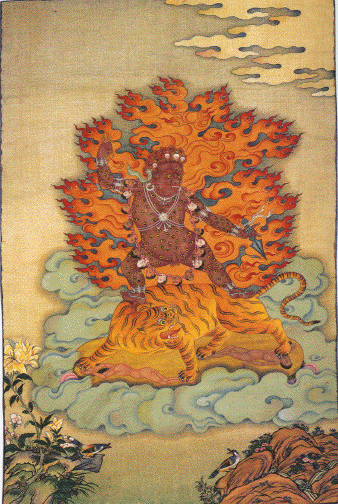
Another interesting reference
is the recent book listed within Tenzin Wangyal Publ. serie:
Magic Dance: The Display of the Self-Nature of the Five
Wisdom Dakinis , By Thinly Norbu - Teachings on the
five elements in the Tibetan Buddhist tradition: earth, water,
air, fire and space. Paperback, 129
pages.
Tsa-rLung Traditional
Healing
Tibetan Traditional
Medicine healing practice ‘Tsa-rLung’, may also be
also called ‘hand healing’, these two Tibetan words meaning,
per se: ‘channels-wind’. Similar to the Reiki and Tai-Ji this
is a Tibetan version of these well known techniques for energy
healing. Similarly it may be traced back in Central Asia and
Tibet Himalayan Shamans, either in Bon-Pos or Amchis
Traditional Healing since thousands of years ago, and so far
has been preserved in the Tibetan Materia Medica, Tsa-rLung
Lamas, Dzogchen Lamas and Nagpas Yoga Lineages, presenting
today various forms all issued from the identical Shamanic
Healing Roots, but sometimes presented to Westerners nowadays
as part of an so-called secret knowledge. Practically, it
simply can be learned, practices and experienced in ways being
similar to other sources, such as in Ajna Yoga, Pranadi /
Pranayama Yogas, Reiki, Tai-Ji and Acupuncture developmental
curricula.
In principle, learning the
techniques of Tsa-rLung healing involves various steps.
Firstly, the body must be attuned to the more subtle
perception level of the energy body for giving healing. The
channels are to be (re-)opened by various embodiments,
breathing exercises, body movements and
visualizations/meditations, and the channels elements and
humours must be well-balanced. Thereafter, using the Tumo Yoga
for heat energy or the Tigle visualization for channelling,
again by means of the personalized energy practices, one must
become able to generate Tumo heat and control the energy, then
to release and control the healing energy. IN principle also,
Tsa-rLung techniques use various type of wind energy to
guide healing energy to the person undergoing
treatment.
However, there is also a more Tantric or
artistic way to perceive and control healing energies by using
Performing Arts, Archetypes Painting Visualisation, Sacred
Dance Embodiment, Divination Rituals, Pujas, Mandalas Yoga and
other Himalayan Shamanic tools, which may apply their
benevolent effect on the soul, mind and body of oneself or of
patients, by opening channels, embody archetypes energy and/or
restoring the balance of the spirits and elements, for purpose
of inspiration, visualization, healing and
rejuvenation.
Shamanic healing techniques, when
duly controlled by an experienced practitioner, may at a same
time cleanse the energy body and open possibility for better
communication between ones higher-self and the normal
consciousness. As soon as a channel between the higher-self
and the consciousness is initiateds, healing and visualization
can go much further. Dreams, divination, intuition,
inspirations, visualization of energy body(ies) and a new
awareness directly will affect, on a very practical and
day-to-day basis, ones very personal experiences. It helps to
bring an entire human being into a more harmonious state of
mind and relationship with people, their natural world or any
contextual circumstances.
Reiki, Shamanic Healing
Traditions and Tibetan healing tradition Tsa-Lung, are working
together. It seems as if a big puzzle is very gently put
together by invisible hands and helps to give us an idea what
our existence could be about.
All these healing
methods whether they are ancient or lately channeled, once we
have worked with them, integrated them into our life and felt
and trusted the inner, hidden message within these techniques,
help us to realize that our life is changing. How could
we possibly not hear the message behind it. Healing and the
development of loving kindness are going hand in hand and help
us to do the next step further.
Cairn Tsa-rLung Healing & Performing
Arts always will include explanations on the concepts, systems
and techniques involved, as well as the medical knowledge
required for proper healing. All participants will be guided
through the exercises and visualisation, and of course
initiated in healing power, when necessary.
Basic Ritual Tsa-rLung
Dance Practices
In order to practice Tantra in general, and
especially the so-called Tibetan Mother Tantra, it is
fundamental to understand the principles of tsa,
lung, thigle and yi-ge. Therefore,
teachings will emphasize detailed instructions and practices
related to these principles. The Mother Tantra subdivides this
chapter into four: tsa, which are the channels or
subtle conductors of our body; lung (Prana), the
energetic winds; thigle, the essential sphere or
seminal essence; and yi-ge, the syllables.
As it is said in Tantra, tsa is to be
perceived as a path, lung as a blind horse, thigle
as a handicapped person riding the horse, and yi-ge
as his or her armor, so that the practitioner who has
complete understanding has the potential power of moving and
protective security. These topics comprise the principal
aspects of the expedient use of Means.
As for the tsa, teachings will explain
the conditions and functions of the three main channels and
the six chakras, and practices to be utilized in order to
clean and unblock the channels such as using vowels and
syllables, sounds, etc.
By means of the lung, one cleans the
channels like clearing the path, so the horse can move.
Thus, with meditation one unties the knots using
sound and vowels, opening and cleaning the channels; and
through focusing one can remove the obstacles and cultivate
knowledge. There are four practices that revitalize the forces
of the lung and five qualities of utilizing
lung, that are to be understood in relation to
different organs, like life in the heart, digestion in the
navel, and so forth.
Regarding the thig-le, we first need a
clean path and a good horse to ride, then we work on the
rider. The Mother Tantra provides detailed descriptions about
pure and impure thig-le(s), both physical and psychic.
Finally, for the yi-ge, Tsa-rLung
Lamas will explain how different sacred syllables represent
the energy or the body of the deities, wisdom, and emotions,
holding and supporting such energies. And also how, through
vocalizing these syllables, one can purify and clean the
channels and heal diseases. This also explains how to relate
with the elements (space, air, fire, water, and earth) by
means of moving the thig-le(s) which ride on the
lung along the tsa(s). It describes five
external, internal, and sacred elements, their nature, and the
magical display of interactions.
Some specific areas of pranic flow are accented
with these different Trance Dance Tsa-rlung moves:
Udana Prana, a spherical area at the head
and neck;
Life-sustaining Prana, an area covering the
chest;
Vyana Prana, egg-shaped pervasive pranas
throughout the body and etheric realm;
Samana Prana, fire of the heart and
naval; and the square wave - traveling
Apana Prana, at the base.
Trance Dance Tsa-rLung is a sequenced
progression of dance moves performed while holding in the
breath. When the Tibetans developed their Tsa-rLung movements,
they based them on two things:
1. Repeated Breath Retention For A Rhythmical
Period Of Time. (Commonly, a sequence of five breaths, each
with five movements.)
2. Rhythmical Sequences Of Movements That Create
Energetic Flow In Specific Pranic Areas.
Energo-Musicotherapy East & West
Bringing together East and West, using the
Tibetan Tsa-rLung Healing power within dance and music will
offer a much needed clarification and fusion of the ancient
art of Tsa-rLung Healing within the modern context and tools,
including modern music. The Cairn Tsa-rLung Performing Arts
& Healing Center current comparative research in the
Celtic artefacts and powerplaces for the utilisation, in situ
and thereupon, of Tibetan Tsa-rLung Healing practices,
embodiment, cleansing and divination, aims to reveal to all
concerned the transcendental qualities of Sacred Dance and
Chanting, and of the Healing Powers which may be found and
transmitted sound, as well the transformational experience it
may release for those who can hear it.
Comprising selected
Tsa-rLung Lamas Healing performers and professional musicians,
the Tsa-rLung Healing Sacred Sounds, Music, Mantras and
Dance... will use a wide variety of Tibetan instruments,
Himalayan bowls, tablas, prayer flutes, guitar, tamboura,
Celtic harp and synthesizer to lift consciousness, and above
all to transmit the Powers of Healing within Sound, Coulours
and supporting Archetypes.
Cairn Tsa-rlung is quite aware of
the problem of lack of context and continuity that sometimes
we westerners undergo when learning meditative practices, plus
our lack of willingness to get involved in foundational
practices and looking instead for a synthesis and
transcultural approach to the Energy Body and its fundamental
resulting core elements, being healing, self-healing,
rejuvenation, and "higher" archetypal practices. Thus, Cairn
Tsa-rLung is seeking ways and means to comparate, test and
transmit with genuine Masters the concerned lineage traditions
to practitioners taking into account the suitable context
needed for any fruitful resourcement and the karmic background
of the body, speech and mind we bring with us,
accordingly.
Celtic Theoretical and
Historical Background
The origin of the “body of light”
is seen in gnostic literature as early as first century.
However, extensive documentation and theory exist in Chinese,
Mongolian, Tibetan, and Indian literature and practices of an
earlier date. Under the general heading of chi kung,
or Chinese internal alchemy, these practices are designed to
create and mature a body of subtle astral and etheric energy
that is capable of existence independent of material
consciousness. This body is also thought to be capable of
infusing the material body with sufficient energy to allow it
to become more subtle and ‘etherial’. This ‘etherialization’
is said to make the physical body, under the direction of the
adept, capable of de-materialization at the time of death.
Enoch, Ezekiel, the ascension of Jesus, his mother Mary, and
even Mohammed with his horse, are often given as examples of
this form of dematerialization in Western spiritual
literature.
Unfortunately, while Eastern
systems have maintained a working technical tradition of the
theory and its application needed to achieve this goal, little
information remains in the West of a similar nature. The idea
of the ‘simulacrum’ is the closest we have, and may very well
be the starting point of such experimentation. It can be seen
from the Eastern literature available, that the idea of the
“Body of Light” often called the “Rainbow” or “Diamond Body”
is the perfection of a vehicle for the exteriorization
(projection), and continuation of consciousness
beyond material reality. This paper will attempt to show how
the development of this body can be achieved through existing
qabalistic practices, and that the stages of its growth
corresponds to total realization on the Lunar
(Yetzirah), Solar (Briah), and Saturnian
(Daath) planes of consciousness.
It is important to realize what
is meant by these ‘planes’ however, as they can be confusing
when first encountered as an esoteric teaching.
Three Levels of
Light
The three basic ideas around the
subtle body are that it progresses though the levels of the
spheres, increases in power and purity, and is made of light
and/or fire. It is described as : the spirit-body, the radiant
body, and the resurrection body, depending on its degree of
purity.
Mead points out that there is the
possibility of extreme confusion when reading the ancient
literature and the vocabulary used to describe the spiritual
body. Despite appearances to the contrary, Mead asserts that
the spiritual body is essentially one, and that the sidereal
body, has nothing to do with today’s (1919) astral body.
While the Christian doctrine of
the resurrection of the flesh was hotly contested during its
developmental stages, with the ‘flesh lovers as they were
called, winning out over those believing in a purely spiritual
resurrection. Mead points out that the belief in physical
resurrection was not universally accepted by the Jews of
Jesus’ day, yet, there was a strong Biblical and midrashic
tradition of increasing in grades of purity of the individual
allowing for ascension and resurrection to take place.
The descriptions of these
accounts, Elijah and Jesus, suggest that the bodies they
inhabited were the same, and yet not the same. They were
tangible, yet could overcome material limitations, such s
Jesus’ passing through the locked door. Elijah, unlike Jesus
however, did not die, but was taken into heaven bodily in a
chariot of fire.
These ‘bodies’ in fact, are not
really separate bodies, but increasingly purified expressions
of the personality, the individual and unique expression of
God we all carry within us. As one ‘body’ or expression is
purified and ‘dies’ another takes its place. What makes the
resurrection body different is that while it can and does
exist within the material world, it is free from material
constraints. This perfect body was, or is, essentially a
quintessence. It is differentiated into subtle and simple
elements, where as the physical body is contaminated by the
grosser elements. The Mithriac initiation states:
“O Primal Origin of my
origination; Thou Primal Substance of my substance; First
Breath of breath, the breath that is in me; First Fire,
God-given for the Blending of the blendings in me; First Fire
of fire in me; First Water of my water, the water in me;
Primal Earth-essence of the earthly essence in me; Thou
Perfect Body of me!..” (p. 102, and A Mithriac
Ritual, London 1907)
Applied Psychology
Higher Education & Career Counselling
e-Center
Cairn
organizes this programme in order to facilitate the access for
European researchers, students and professionals to relevant
Euro-Asia
Transcultural Counselling Field- Research &
Courses Options in
Nepal, India, Tibet/ TAR China and most of S-Asia. Options
include training resources in Rehabilitation, Crisis,
Vocational, Career and/or Educational Counselling, as well as
in experiential psychotherapy training in Tibetan
Traditional Medicine Psychotherapy (Tsa-rLung Healing). These
can be linked easily to the participants backgrounds within
the discipline of Clinical Anthropology, Health Anthropology,
Social/Health Education, Applied Psychology to Counselling,
Ethno-medicine, Phenomenology, Transpersonal (Holistic)
Psychotherapy, as well as Applied Psychology to HRD and
Organization Management. A short list of high quality online
training resources and practitioners has been selected for
designing, delivering, coaching and facilitating the inputs at
the various professional levels required for ECTS/ECDL credits
in professional training research certification.
Cairn organizes the present
Options, based upon a stepwise cultural
appropriate approach, being the chronological succession of
five (5) Modules and seven (7) Sub-Modules (Levels) of
scheduled courses and/or
field- research options and activities, namely:
TEACHING
PROGRAMME
Please choose amongst CAIRN Modules and
Options hereunder:
|


![]()
